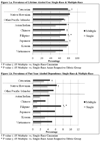Substance use and dependence among Native Hawaiians, Other Pacific Islanders, and Asian ethnic groups in the United States: contrasting multiple-race and single-race prevalence rates from a national survey
- PMID: 20737344
- PMCID: PMC2929933
- DOI: 10.1080/15332640.2010.500582
Substance use and dependence among Native Hawaiians, Other Pacific Islanders, and Asian ethnic groups in the United States: contrasting multiple-race and single-race prevalence rates from a national survey
Abstract
The percentage of multiracial youth appears to be increasing in the United States. However, little has been disseminated about problem behaviors among multiracial Native Hawaiians, Other Pacific Islanders, and Asians on a national level. Using the National Survey on Drug Use and Health, the authors compared multiple-race Native Hawaiians, Other Pacific Islanders, and Asians, while disaggregating by ethnic subgroups, with single-race individuals within respective Asian ethnic subgroups and Caucasians for prevalence of alcohol/drug use and dependence. For multiple-race Native Hawaiians, Other Pacific Islanders, and Asians, high rates of alcohol dependence were observed compared with both single-race Native Hawaiian, Other Pacific Islander, and Asian subgroups and single-race Caucasians; for some multiracial Native Hawaiians, Other Pacific Islanders, and Asians, high rates of drug dependence were also observed.
Figures


Similar articles
-
Differences in Coronary Heart Disease and Stroke Incidence Among Single-Race and Multiracial Asian and Pacific Islander Subgroups in Hawaii and California: A Retrospective Cohort Study.J Am Heart Assoc. 2025 May 6;14(9):e039076. doi: 10.1161/JAHA.124.039076. Epub 2025 Apr 16. J Am Heart Assoc. 2025. PMID: 40240959 Free PMC article.
-
More than black and white: differences in predictors of obesity among Native Hawaiian/Pacific Islanders and European Americans.Obesity (Silver Spring). 2012 Jun;20(6):1325-8. doi: 10.1038/oby.2012.15. Epub 2012 Jan 28. Obesity (Silver Spring). 2012. PMID: 22286530 Free PMC article.
-
Illicit and nonmedical drug use among Asian Americans, Native Hawaiians/Pacific Islanders, and mixed-race individuals.Drug Alcohol Depend. 2013 Dec 1;133(2):360-7. doi: 10.1016/j.drugalcdep.2013.06.008. Epub 2013 Jul 23. Drug Alcohol Depend. 2013. PMID: 23890491 Free PMC article.
-
Substance use disorders and co-morbidities among Asian Americans and Native Hawaiians/Pacific Islanders.Psychol Med. 2015 Feb;45(3):481-94. doi: 10.1017/S0033291714001330. Epub 2014 Jun 20. Psychol Med. 2015. PMID: 25066115 Free PMC article. Review.
-
Toward improved health: disaggregating Asian American and Native Hawaiian/Pacific Islander data.Am J Public Health. 2000 Nov;90(11):1731-4. doi: 10.2105/ajph.90.11.1731. Am J Public Health. 2000. PMID: 11076241 Free PMC article. Review.
Cited by
-
Ke ala i ka Mauliola: Native Hawaiian Youth Experiences with Historical Trauma.Int J Environ Res Public Health. 2022 Oct 1;19(19):12564. doi: 10.3390/ijerph191912564. Int J Environ Res Public Health. 2022. PMID: 36231865 Free PMC article.
-
Higher Marijuana use among Young Adults Persists Even during Pregnancy.J Gynaecol Obstet Adv. 2021;1(1):23-29. Epub 2021 Apr 29. J Gynaecol Obstet Adv. 2021. PMID: 35419573 Free PMC article.
-
Racial discrimination, racial identity affiliation, and heavy alcohol use among multiracial individuals.Alcohol Clin Exp Res. 2021 Aug;45(8):1653-1663. doi: 10.1111/acer.14651. Epub 2021 Aug 13. Alcohol Clin Exp Res. 2021. PMID: 34388267 Free PMC article.
-
Gambling problems and comorbidity with alcohol use disorders in Chinese-, Korean-, and White-American college students.Am J Addict. 2016 Apr;25(3):195-202. doi: 10.1111/ajad.12350. Epub 2016 Mar 3. Am J Addict. 2016. PMID: 26935871 Free PMC article.
-
Community-Focused Policy Advocacy: Evaluating Hawai'i's Historical Trauma Legislation.Hawaii J Health Soc Welf. 2023 Oct;82(10 Suppl 1):44-50. Hawaii J Health Soc Welf. 2023. PMID: 37901667 Free PMC article.
References
-
- American Psychiatric Association. Diagnostic and statistical manual of mental disorders. 4th ed. Washington, DC: Author; 1994. (DSM IV)
-
- Bratter JL, King RB. “But Will It Last?": Marital instability among interracial and same race couples. Family Relations. 2008;57:160–171.
-
- Campbell ME, Eggerling-Boeck J. “What about the children?” The psychological and social well-being of multiracial adolescents. Sociological Quarterly. 2006;47:147–173.
-
- Cauce A, Hiraga Y, Mason C, Aguilar T, Ordonez N, Gonzalez N. Between a rock and a hard place: Social adjustment of biracial youth. In: Root MPP, editor. Racially mixed people in America. Newbury Park, CA: Sage; 1992. pp. 245–252.
-
- Cohen J, Cohen P, West SG, Aiken LS. Applied multiple regression/correlation analysis for the behavioral sciences. 3rd ed. Mahwah, NJ: Lawrence Erlbaum Associates; 2003.
Publication types
MeSH terms
Grants and funding
LinkOut - more resources
Full Text Sources
Medical
